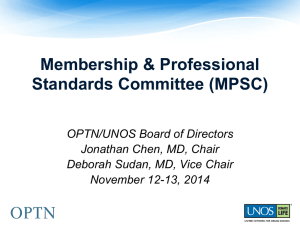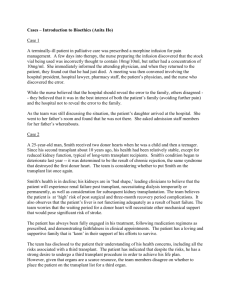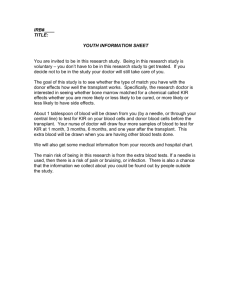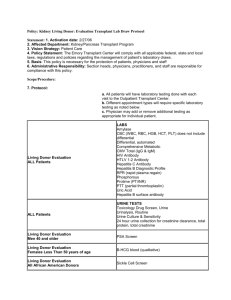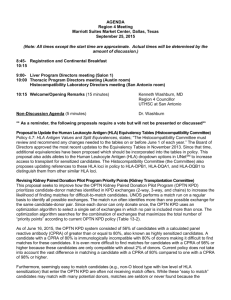MEETING SUMMARY Region 1 Meeting September 30, 2013 An
advertisement
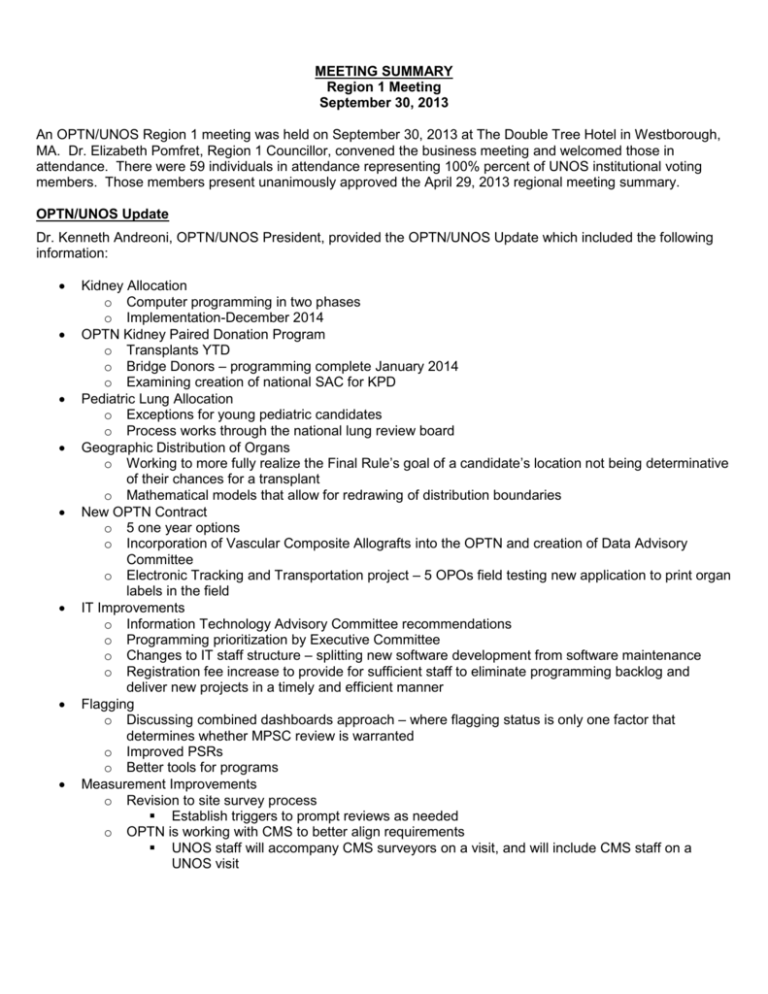
MEETING SUMMARY Region 1 Meeting September 30, 2013 An OPTN/UNOS Region 1 meeting was held on September 30, 2013 at The Double Tree Hotel in Westborough, MA. Dr. Elizabeth Pomfret, Region 1 Councillor, convened the business meeting and welcomed those in attendance. There were 59 individuals in attendance representing 100% percent of UNOS institutional voting members. Those members present unanimously approved the April 29, 2013 regional meeting summary. OPTN/UNOS Update Dr. Kenneth Andreoni, OPTN/UNOS President, provided the OPTN/UNOS Update which included the following information: Kidney Allocation o Computer programming in two phases o Implementation-December 2014 OPTN Kidney Paired Donation Program o Transplants YTD o Bridge Donors – programming complete January 2014 o Examining creation of national SAC for KPD Pediatric Lung Allocation o Exceptions for young pediatric candidates o Process works through the national lung review board Geographic Distribution of Organs o Working to more fully realize the Final Rule’s goal of a candidate’s location not being determinative of their chances for a transplant o Mathematical models that allow for redrawing of distribution boundaries New OPTN Contract o 5 one year options o Incorporation of Vascular Composite Allografts into the OPTN and creation of Data Advisory Committee o Electronic Tracking and Transportation project – 5 OPOs field testing new application to print organ labels in the field IT Improvements o Information Technology Advisory Committee recommendations o Programming prioritization by Executive Committee o Changes to IT staff structure – splitting new software development from software maintenance o Registration fee increase to provide for sufficient staff to eliminate programming backlog and deliver new projects in a timely and efficient manner Flagging o Discussing combined dashboards approach – where flagging status is only one factor that determines whether MPSC review is warranted o Improved PSRs o Better tools for programs Measurement Improvements o Revision to site survey process Establish triggers to prompt reviews as needed o OPTN is working with CMS to better align requirements UNOS staff will accompany CMS surveyors on a visit, and will include CMS staff on a UNOS visit Ad Hoc Disease Transmission Advisory Committee Proposal to Modify Deceased Donor Testing Requirements This proposal seeks to modify current deceased donor testing requirements in policy based upon updated testing kit availability and laboratory practice, and also clarify any points of confusion for the OPO community. Current test requirements stemmed from changing test kit availability and a widely publicized transmission event in 2007. Over the years, there have been a number of questions regarding the application of this language from OPOs that do not understand the terminology or wish to use tests outside of the current requirements. Region 1 Vote: 19 yes, 0 no, 0 abstentions Comments: The region voted to approve the proposal with the following comment: Policy 2.2.3.2 should be deleted. This policy requires an OPO to re-test a deceased donor for HIV if the donor receives subsequent transfusions that were not tested for HIV, even if the donor was tested for HIV previously with a qualified blood sample and the result was negative. The region couldn’t imagine a scenario where a donor would be transfused with blood that wasn’t tested for HIV. In addition, the OPO might not know that the blood wasn’t tested for HIV and therefore wouldn’t know to re-test the donor. Histocompatibility Committee Proposed Histocompatibility Policy Rewrite This proposal reflects recommendations from the Histocompatibility Committee (‘the committee’) following a comprehensive review of the OPTN policies governing histocompatibility testing. The committee is proposing several changes in order to align OPTN testing requirements with those in federal regulations. Some changes are in response to requests from UNOS staff to resolve issues with policies identified as difficult to monitor. Finally, the committee is proposing to eliminate numerous sections of the current policies because they are outdated or adequately addressed in the standards required by histocompatibility accrediting agencies (ASHI and CAP). In recognition of the fact that testing methods and technology continue to evolve and clinical practice for histocompatibility testing often varies among patients, the committee intends to move most of the sections proposed for elimination from policy into a guidance document that will be developed at the conclusion of this process. The committee hopes to achieve the following goals with this proposal: promote transplant safety by requiring histocompatibility laboratories to accurately determine and report HLA typing and resolve HLA typing discrepancies in a timely manner simplify OPTN policies conveying the HLA types required to be reported by organ align OPTN policies for crossmatching with federal regulations eliminate policies that are outdated or adequately addressed in the standards required by histocompatibility accrediting agencies (ASHI and CAP) Region 1 Vote: 17 yes, 1 no, 0 abstentions Comments: The region approved the proposal with the following comments: Bylaw D.4 (A) should be amended to include that the final crossmatch can be a physical or virtual crossmatch. The region discussed the bylaw language pertaining to discrepant HLA typing results. Several members of the region think that the discrepancies should be resolved pre-transplant and that the committee should move toward the identification of discrepant results in real time. Living Donor Committee Proposal to Establish Minimum Requirements for Living Liver Donor Follow-Up This proposal would require transplant programs to report required fields on the Living Donor Follow-Up (LDF) form at required post-operative reporting periods (6, 12, and 24 months). The OPTN currently relies on Living Donor Follow-Up (LDF) forms to collect data on the short-term health status of living donors. Data on living donors who donated since 2006 demonstrate that many programs do not report meaningful living donor follow-up information at required reporting intervals. Consequently, to allow for meaningful analyses to objectively study the short-term effects of living donation, the transplant community must collectively improve reporting of patient information on the LDF form. The proposed minimum reporting requirements are based on recommendations from the Joint Society Work Group, which is composed of representatives from the American Society of Transplantation (AST), the American Society of Transplant Surgeons (ASTS), and the North American Transplant Coordinators Organization (NATCO) to the OPTN/UNOS Living Donor Committee. Region 1 Vote: 18 yes, 0 no, 0 abstentions Approved as written Proposal to Require UNetsm Registration of all Living Donor Organ Candidates Prior to Transplant Under this proposal, all candidates for living donor transplants would be required to be added to the waiting list before their transplant. All living donor organ recipients are already reported to UNetsm and are charged a registration fee, just like candidates for deceased donor organs. Most transplant programs add living donor organ transplant candidates to the waiting list prior to the transplant procedure via Waitlist sm, while other programs may report a living donor organ transplant recipient after the transplant occurs via Tiedism. Patient safety benefits associated with registering a candidate prior to transplant, include improved blood type verification prior to the transplant procedure, providing unique identifiers for comparing donor and candidate information, and the accrual of wait time. Please note that this proposal would not change the registration fees paid to the OPTN contractor. Region 1 Vote: 17 yes, 0 no, 0 abstentions Approved as written Membership and Professional Standards Committee Proposal to Revise the Current Method for Flagging for Transplant Program Post-transplant Performance Reviews The purpose of this proposal is to better identify those transplant programs that may be underperforming in the area of patient and graft survival. The Bylaw proposal adopts the new Bayesian methodology that will be utilized by the SRTR in the production of the public transplant program performance metrics and establishes new flagging thresholds that maximize the true positive flags while minimizing false positive flags. In doing so, the transplant programs most in need of MPSC review and assistance in improving outcomes will be flagged. Region 1 voted to approve the Bayesian methodology with a vote of 15 yes, 0 no, 3 abstentions. With a vote of 6 yes, 7 no, 2 abstentions, Region 1 did not approve the proposed flagging thresholds for the following reasons: The region thinks that too many programs are being flagged and establishing new thresholds that essentially flag the same number of programs as the current thresholds isn’t an improvement. The region prefers a tiered approach to flagging. Fewer centers should be flagged and they shouldn’t be flagged publically. The MPSC should determine where the new baseline should be for flagging thresholds in order to flag programs that are truly underperforming. Proposed Patient Notification of Lack of Transplant Functional Inactivity The purpose of this proposal is to provide, through a requirement for patient notification, candidates and potential candidates with information about the program’s activity levels that will allow the patient to make informed decisions about whether to move to another more active program or multiply list at another program. In addition, the proposed Bylaw revision may provide an incentive for a low volume program to develop ways to increase transplant activity thereby positively impacting the program personnel’s experience and currency. In the alternative, it may spur a functionally inactive program to examine whether there is sufficient need in the community to justify the maintenance of the functionally inactive program resulting in the inactivation or withdrawal of a low volume program with the resultant referral of candidates to a higher volume program. Region 1 Vote: 12 yes, 3 no, 0 abstentions Comments: The region approved the proposal but commented on the analysis that was performed to determine the number of programs located in proximity to a program identified as very low volume. The analysis didn’t provide information reagrding the volume or outcomes of the centers located nearby. The nearby centers could be low volume with no better transplant rate or outcomes. In addition, the definition of a potential candidate in the bylaws is vague and should be revised.
